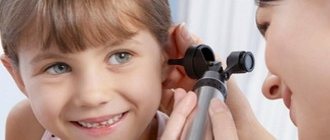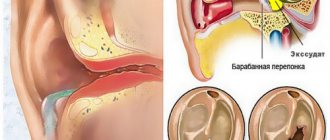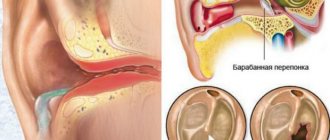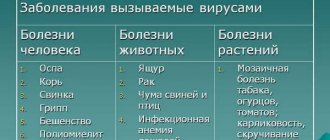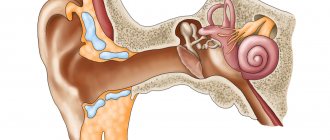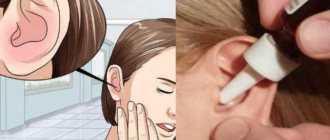What is adhesive otitis media
The inflammatory process in which adhesions or scar tissue forms in the middle ear is called adhesive otitis media.
With this chronic disease, the mobility of the auditory ossicles and the patency of the Eustachian tube decrease. The symptoms are mild, the pathology gradually progresses, leading to hearing loss. The disease develops during an inflammatory process when a large amount of exudate accumulates in the tympanic cavity.
Adhesions form in the middle ear and scars appear. As a result, the mobility of the auditory ossicles decreases, and the full volume of sound does not enter the inner ear. If sound conduction is impaired, a person may become deaf.
Why is it dangerous?
Doctors identify the following complications of adhesive inflammation of the middle ear:
- immobility of the auditory ossicle;
- complete hearing loss;
- hearing loss of varying intensity.
Stages of development
The main signs of the disease are tinnitus and hearing loss. The clinical outcome of adhesive otitis media depends on the stage at which hearing loss is detected:
- Easy . A small number of adhesions that do not significantly reduce hearing acuity.
- Average . Liquid discharge appears in the layer of the deformed eardrum, atrophied scars are clearly visible, and hearing decreases.
- Heavy . Excess connective tissue deforms the eardrum and scars form. The person has difficulty hearing.
What is adhesive otitis media and how is it treated?
Chronic adhesive otitis media of the middle ear is a severe inflammatory disease that can lead to complete or partial hearing loss. A characteristic feature of the disease will be the formation of adhesions and cords, deterioration of the patency of the auditory canal and the mobility of the bones that create the structure of the hearing aid. All this is accompanied by a sharp deterioration in hearing and painful sensations. If you have the slightest suspicion, you should immediately consult an otolaryngologist for further diagnosis and treatment.
Causes
Among the most common factors in the occurrence of the disease are previous ENT diseases, congenital anatomical features of the structure of the auditory canal and many other reasons. Often the disease is “masked” as ordinary otitis media and only a specialist can recognize its true nature after extensive research. Here are the symptoms and treatment at home for different types of otitis media. The link describes the signs of otitis media in infants.
The reasons for the development of this disease:
- Consequences of inflammatory processes of the hearing aid.
- Uncontrolled use of antibiotics and improper treatment.
- Acute forms of ENT diseases.
- Seasonal exacerbation of sinusitis.
- Complications after sinusitis or even ordinary rhinitis (runny nose).
- Deviated nasal septum (congenital or acquired).
- Adenoids.
- Polyps and tumors of the nasal cavity or pharynx.
- Frequent inflammatory processes tolerated without proper treatment.
- Dental problems.
The video explains in detail about adhesive otitis media:
The best prevention of this disease will be professional help from a doctor for all types of ENT problems, as well as refusal of thoughtless treatment with antibiotics. All medications must be agreed upon with the attending physician, otherwise there is a risk of developing severe consequences not only for the hearing organs, but also for the functioning of the entire body as a whole. Possible treatment of otitis media with antibiotics in adults is described here.
Diagnostics
As mentioned earlier, only a specialist can accurately determine adhesive otitis media, and several examinations are necessary to exclude other options and make an accurate diagnosis.
Measures for diagnosing adhesive otitis media:
- Examination by an otolaryngologist.
- Carrying out audiometry - a special procedure consisting of “blowing through” the ear canal using the Politzer method. If there is another disease, blowing guarantees a very effective effect, but in the case of adhesive otitis media there will be practically no result.
- Otoscopy is an examination with magnification that allows you to accurately see possible adhesions or scar changes in the structure of the middle ear.
- Determination of the degree of patency of the auditory canal.
- Acoustic impedance testing is also a very useful examination, determining the mobility of the auditory ossicles and the degree of distensibility of the eardrum. If the normal functioning of the hearing aid is impaired, the elasticity of the membrane is limited or absent altogether, we can conclude that adhesive otitis media is present.
You should not be afraid to undergo a full examination, because this is how you can create a complete picture of the disease and determine its severity and future prospects. In the absence or incomplete treatment, the threat may be complete loss of hearing, as well as progression of the disease and damage to other organs. The results of all special examinations will confirm or refute the diagnosis of “adhesive otitis media,” which will allow the doctor to prescribe a treatment plan.
Find out if you can make a compress for a purulent sore throat.
What does it mean if you have a sore throat, runny nose and stuffy ears?
Reviews on the use of milk with figs for cough: https://prolor.ru/g/lechenie/inzhir-s-molokom-ot-kashlya-recept.html.
How to treat
What treatment regimen for otitis media is used for this disease? In order to get rid of the disease, it is first necessary to remove the provoking factor. For this purpose, drug treatment is prescribed. In case of pathological structure of organs, surgical intervention is required. The reasons that led to the disease include any kind of infection, so complete sanitation of the oral cavity, sinuses and larynx may be required. In children, adenoid removal may be necessary, but only in emergency cases if other treatments are ineffective. A deviated nasal septum can also cause adhesive otitis media, so this factor must also be removed.
Second stage: manipulation using special equipment. According to the treatment plan, this is usually blowing using the Politzer method, already mentioned earlier as diagnostic measures. The difference will be the simultaneous implementation of pneumomassage of the tympanic septum and the introduction of special medications into the auditory canal.
The video explains how to treat and cure adhesive otitis media:
Physiological procedures are also very effective. This can be UHF heating, microwave therapy, ultrasonic massage and even mud therapy. All these procedures do not replace drug treatment, but in combination they give a greater effect and help to cope with the disease faster.
During treatment, patients are recommended to take multivitamins, especially group B. This measure promotes better progress and recovery. To avoid allergic reactions, you should also take antihistamines.
Home methods, unfortunately, are not suitable for the treatment of adhesive otitis media; moreover, they can cause progression of the disease and serious consequences, so it is not worth the risk. Additional measures, such as warming with a “blue” lamp, the introduction of tampons with various homemade decoctions and mixtures, must be agreed with the doctor.
Some “grandmother’s” methods of treating inflammatory processes of the middle ear can alleviate the symptoms of the disease and enhance the effectiveness of official treatment. The main requirement is that all measures must be coordinated with the attending physician, and not with the advice of “knowledgeable” people without proper qualifications.
On the video - review “How I cured adhesive otitis media”:
Surgical methods for treating adhesive otitis involve excision of scars on the surface of the auditory ossicles. This is an extremely complex and unpredictable procedure, the implementation of which does not guarantee restoration of the organ’s functioning. Often such operations do not bring tangible benefits and require prosthetics of some elements. The prognosis is especially disappointing for the youngest patients: in childhood, such operations are practically not performed due to the high risk of repeated tissue scarring. This defeats the purpose of costly and dangerous surgery.
The main danger of adhesive otitis is the irreversibility of existing changes. Treatment can only stop the progression of the disease, but not return the organ to its original state. With timely treatment, it is possible to avoid complete deafness, but hearing acuity will still be slightly lost.
Adhesive otitis media of the middle ear is a serious disease, the treatment of which must be approached with all responsibility. Correct diagnosis and timely contact with a specialist will help stop the disease in time, but it has not yet been possible to completely restore the affected organ. You may also find information about the symptoms of catarrhal otitis media helpful. The link describes ear drops for otitis media in adults. And here you will find children's ear drops for otitis media.
ProLor.ru>
Adhesive otitis media ICD
According to ICD-10, this disease is coded under the code H74.1 “Adhesive disease of the middle ear.” This term refers to an inflammatory pathology that results from prolonged fluid retention in the middle ear.
As pathology develops, the patency of the tubes that connect the nasal cavity to the middle ear is disrupted. As a result, adhesive changes, dense areas of connective tissue, and adhesions are formed. All this makes the auditory ossicles less mobile and reduces the conductivity of sounds.
Diagnosis of bilateral adhesive otitis media
If there is a suspicion of chronic adhesive otitis media, mandatory diagnostic tests are a visual examination by an otolaryngologist, audiometry, otoscopy, impedance measurement and a study of the patency of the ear canal.
When diagnosing otitis of this type, it is very important to clearly determine the otoscopic picture of the disease. Otoscopy is distinguished between simple and magnified, it allows you to determine the retraction of the eardrum, the presence of scar changes on it or its cloudiness. Also, cords and adhesions can be visualized in the cavity of the auditory tube, which sometimes completely fill its lumen.
Carrying out audiometry for bilateral adhesive otitis helps to identify the severity of hearing loss in patients. To determine the patency of the auditory tube, it is blown using the Politzer method. If the patient truly has adhesive otitis media, then this procedure gives little or no effect. However, to definitively confirm the diagnosis, they resort to catheterization of the tube with mandatory otoscopic control.
The mobility of the auditory ossicles, like the distensibility of the eardrum, is measured during a procedure called acoustic impedance measurement. The essence of the procedure is the consistent discharge and condensation of the air in the auditory tube. As a result of such manipulations, the eardrum should straighten and retract. When diagnosing adhesive otitis media, the movement of the membrane is very limited or completely absent, and muscle acoustic reflexes are not evoked.
Causes and course of the disease
At the heart of the “adhesive” process in the middle ear, two elements play a major role: inflammatory diseases of the middle ear and the processes of the emergence of pathological contents in the tympanic cavity. Because of this, there is a violation of the drainage and ventilation functions of the auditory tubes, and then transudation (the release of the liquid part through the tissue gaps) and exudation of the secretion into the tympanic cavity. Thus, the middle ear goes through all three stages of developing inflammation, thereby forming scars and adhesions from the tympanic cavity of the middle ear and auditory tubes.
With adhesive otitis media, the following pathological picture occurs: strong scar cords are formed, which can look like threads or be filmy, but at the same time quite massive. They entwine the chains of the auditory ossicles and fix them in a certain position, which greatly limits the movement of the entire chain of auditory bones, thereby causing stiffness and impairing hearing through the sound conduction mechanism.
Causes of adhesive otitis media
The most common cause of adhesive otitis media is chronic tubootitis, catarrhal or exudative non-perforative otitis. After these diseases, the development of adhesive otitis media can be provoked by irrational antibiotic therapy. As a result, the inflammatory process expands and the exudate accumulated in the tympanic cavity resolves. The patency is impaired, as scar cords and connective tissue adhesions form in it, leaving a fibrin thread. Adhesions and scar cords are attached to the eardrum and entwine the auditory ossicles, blocking the mobility of these structures, without which normal sound transmission is impossible. At the same time, strands and adhesions of adhesive otitis media also form in the auditory tube, which impairs its patency.
In clinical otolaryngology, there are often cases where otitis media occurs as an independent disease, without previous chronic or acute otitis. In such situations, pathological processes that interfere with normal ventilation of the tympanic cavity and impede the patency of the auditory tube have a decisive influence on its occurrence. These include:
- chronic tonsillitis;
- acute diseases of the upper respiratory tract (pharyngitis, ARVI, laryngitis, tracheitis);
- adenoids;
- hypertrophic changes in the inferior turbinates;
- chronic inflammatory processes of the nasal cavity and paranasal sinuses (sinusitis, sinusitis, rhinitis);
- deviated nasal septum;
- tumors of the pharynx and nasal cavity.
Symptoms of adhesive otitis media
If with purulent otitis the first signs are noticeable (sharp pain, elevated body temperature), then adhesive middle ear disease is not so noticeable. Therefore, people can put off going to the doctor for a long time, which leads to the spread of the disease.
The main symptoms of adhesive otitis media are hearing loss, clicking and noise in the affected ear, and a feeling of fullness. Rarely, patients complain of pain, ear discharge and general poor condition. The patient's history usually includes a long runny nose and previous chronic and acute otitis media.
With bilateral adhesive otitis, both ears are inflamed, so symptoms are observed on both sides. This form of the disease has a more unfavorable prognosis.
If you have problems with your hearing, you should contact an ENT specialist.
In adults
Adhesive otitis media is not characterized by obvious symptoms, so patients very rarely experience pain in the ear or discharge from the ear canal. The general condition usually also remains unchanged.
The main symptom of this type of otitis is increasing hearing impairment, problems with sound perception, and tinnitus. These manifestations are constantly present. Moreover, sometimes the noise becomes so strong that a person has to go to the doctor.
To diagnose the pathology, the ENT must interview the patient and find out whether he has had acute or. The specialist then performs an otoscopy. During examination of the eardrum, it is necessary to evaluate its retraction, deformation, and scar processes.
Preservation of the mobility of the tympanic membrane can be assessed by tympanometry. Valsalva maneuvers and Siegle's funnels are also of great diagnostic value. If the process is started, the membrane loses its mobility.
Using tympanometry, the function of the joints located between the bones is assessed. With adhesive otitis media, ankylosis occurs, which manifests itself as a lack of mobility. These changes lead to hearing loss.
To assess the degree of hearing loss, special tests are performed - audiometry, tests with a tuning fork. To identify the adhesive process, you can perform blowing. In the absence of air in the tympanic cavity, we are talking about complete fusion of the pipe.
To determine the severity of the disease, computed tomography or magnetic resonance imaging of the temporal bone is performed. With these studies, it is possible to view inaccessible structures of the ear.
Signs of adhesive otitis media
Since the disease reduces hearing acuity, it is necessary to respond to problems in a timely manner, to distinguish adhesive from other forms of otitis, similar in symptoms to diseases of the ENT organs. Characteristic features:
- subjective tinnitus;
- nasal congestion;
- high body temperature;
- no pain or discharge from the ear;
- gradual hearing loss;
- increased sweating in children.
Phases
The disease can have a different course. Moreover, each phase of adhesive otitis is accompanied by characteristic manifestations.
Acute
When inflammation occurs in the tympanic cavity, which is accompanied by weakening of ventilation and fluid outflow. Over time, the exudate becomes thicker and forms dense threads. They entwine the auditory ossicles, disrupting their mobility.
Chronic
If treatment is not started in time, the mucous membrane undergoes serious changes. In this case, scars and adhesions form on its surface. As a result, the mechanism of sound transmission is disrupted, which leads to hearing loss. This pathology is characterized by the appearance of low-frequency noise and increasing hearing impairment.
Medical information portal "Vivmed"
ADHESIVE MIDDLE EAR DISEASE (tympanosclerosis) - proliferation of connective tissue in areas of the middle ear with subsequent hyalinosis. Etiology The disease is a consequence of long-term retention of exudate in the tympanic cavity during otitis, not accompanied by perforations of the eardrum and with significant impairment of the patency of the auditory tubes. Diseases of the mucous membrane of the upper respiratory tract (nose, paranasal sinuses and nasopharynx) contribute to the occurrence of an inflammatory process, initially in the auditory tube, and then in the tympanic cavity. Pathogenesis The essence of this disease is the formation of dense connective tissue, adhesions, adhesions, calcification and ossification in the middle ear cavity. Hyalinization of the mucous membrane surrounding the auditory ossicles, adhesions between the eardrum, auditory ossicles and the medial wall of the cavity lead to limitation or complete immobility of the sound conducting system of the middle ear. Particularly severe hearing loss (deafness) occurs when scar tissue develops in the area of the labyrinthine windows. Clinic Characteristic: persistent progressive hearing loss, accompanied by tinnitus. Diagnostics Otoscopy reveals a dull thickened or atrophied in some areas eardrum with a stringy pattern, retractions, and lime deposits. When examined using a pneumatic Siegle funnel, complete or partial immobility of the eardrum is determined. When examining hearing, its sharp decrease is determined, mainly due to the type of damage to the sound-conducting apparatus, but sometimes also to the sound-receiving apparatus. Help in making a diagnosis is a history of diseases of the nose, nasopharynx and middle ear. Treatment Requires elimination of upper respiratory tract diseases. Improving the patency of the auditory tubes is achieved by blowing the ears in combination with pneumatic or vibration massage of the eardrum and the chain of auditory ossicles. Faradization of the ears is carried out using the Tsitovich method. Diathermy and mud therapy are recommended; administration of lidase, hydrocortisone, and chymotrypsin into the tympanic cavity is indicated. For intense tinnitus, Beloid is recommended. In case of severe hearing loss that is not amenable to conservative treatment, surgical intervention (tympanoplasty) is used, which consists of tympanotomy followed by excision of scars and adhesions, mobilization of the stapes, replacement of functionally defective elements with polyethylene prostheses, etc.
Types of disease
Depending on the severity and duration, the disease is divided into the following types:
- Chronic adhesive otitis media. It develops gradually and has a sluggish character. May not bother you for a long period of time.
- Bilateral adhesive otitis media. Appears when both ears are affected with the same severity. This type of disease is very difficult to treat.
Adhesive otitis media of the middle ear is a fairly serious disease that can lead to serious consequences. Therefore, timely diagnosis and correct treatment are necessary.
Adhesive otitis media: treatment
The task that is set primarily in the treatment of adhesive otitis is to restore the patency of the auditory tube. To do this, the nasal cavity is sanitized and normal breathing is restored. It is also necessary to relieve swelling and inflammation of the mucous membrane.
For these purposes, a course of blowing or catheterization is carried out. Before performing them, the nose must be cleaned and instilled with vasoconstrictor drops. Both procedures are painful, so the nasal membrane is treated with analgesics. The course of blowing is 3-10 sessions, they are carried out after 1-2 days, which will completely get rid of the accumulated exudate and restore normal pressure in the tympanic cavity. Catheterization with an ear catheter followed by injection of medications directly into the middle ear helps resolve adhesions and relieve swelling.
Among the drugs used to wash the ears for adhesive otitis media:
- Hydrocortisone. This is a glucocorticoid, that is, a hormonal drug. It inhibits allergic reactions, relieves inflammation, suppresses the development of connective tissue;
- Lidaza. The active ingredient is hyaluronidase, which breaks down hyaluronic acid and leads to the softening of scars and the resorption of bruises. Has astringent properties;
- Chymotrypsin. Actively breaks down fibrin adhesions that form during adhesive otitis, dilutes viscous exudate;
- Dexamethasone. This is a stronger drug than hydrocortisone. It has anti-allergic and anti-inflammatory properties.
Vasoconstrictor drops are also prescribed as part of treatment.
Popular remedies that constrict blood vessels, stop fluid secretion, relieve swelling and restore normal breathing:
- Naphthyzin;
- Nazol or Nazolin;
- Sanorin.
They are instilled into each nasal passage, 1-3 drops 2-3 times a day. The active ingredient of these drugs is naphazoline nitrate. They are used for diseases such as rhinitis, eustachitis, sinusitis, laryngitis.
How to get rid of noise with adhesive otitis media? Among the medications used that help reduce tinnitus are 2% Novocaine solution, 75% alcohol, Hexonium, Tropacin, Amizil, Spherofizin. They are inserted through a puncture in the eardrum.
With the help of a Politzer balloon, which is used for blowing, pneumomassage is carried out by exposure to pressure changes. In this way, the eardrum is stimulated and its mobility is restored. Pneumatic massage is alternated with blowing, which improves the result.
Physiotherapeutic procedures such as:
- UHF (tissue heating occurs under the influence of electrical or ultrasonic vibrations). UHF improves blood circulation and other metabolic processes in the required area, promotes rapid regeneration and recovery, relieves swelling and inflammation;
- microwave therapy (use electromagnetic waves, which also accelerate particle movement and heat). The effect is the same as with UHF;
- intraaural electrophoresis. During electrophoresis, an electrode is used that emits a direct current, and a swab soaked in a medicinal solution and applied to the ear. An electrode may also be placed in the nose. The current enhances and prolongs the effect of the drug, which is used as bactericidal, trophostimulating and anti-inflammatory drugs (iodine, alcohol, distilled water, lidase, etc.). Electrophoresis is an excellent prevention of scars in the middle ear.
The doctor selects treatment methods and prepares a course of physical procedures individually.
Treatment of adhesive otitis media
In the treatment of adhesive otitis media, the first stage is the elimination of factors that lead to disruption of the patency of the auditory tube. Thus, this includes adenotomy in children, sanitation of the nasal sinuses and nasopharynx, restoration of normal breathing through the nose (elimination of hypertrophy of the nasal turbinates and curvature of the nasal septum).
For adhesive otitis media, a course of Politzer purges, which is combined with pneumomassage of the eardrum, has a positive effect. Transtubular administration of fluimucil, lidase, hydrocortisone, and chymotrypsin is also practiced through a catheter. For patients diagnosed with otitis media, aloe vera, parenteral use of FiBS, ATP, B vitamins, etc. are recommended to stimulate the body's defense reactions. Treatment of adhesive otitis media is difficult to imagine without antihistamines.
Physiotherapeutic treatment is an addition to drug therapy for adhesive otitis media. Microwave therapy, mud therapy, UHF, and ultrasonic massage of the auditory tube rollers are used. The administration of lidase and potassium iodide is carried out by endoural electrophoresis and ultraphonophoresis.
Conservative treatment of adhesive otitis media is often ineffective. Surgical treatment is indicated in such cases and for progressive hearing loss. Carrying out tympanotomy with restoration of mobility of the auditory ossicles and dissection of scar-adhesive cords often gives only a temporary result. The fact is that in most cases, after surgery, re-formation of adhesions occurs. Tympanoplasty is more effective when replacing the auditory ossicles with artificial ones. In case of bilateral adhesive otitis media with severe hearing loss, as well as in elderly patients, hearing aids are prescribed.
Typically, courses of complex treatment are repeated 2-3 times a year. It all depends on the specific case and individual characteristics of the patient.
Consequences and methods of prevention of adhesive otitis media
Advanced adhesive otitis media can lead to irreversible hearing loss and deafness. There is also a possibility of return after treatment and transition to a chronic form. Complications of adhesive otitis media require more severe and lengthy treatment.
To prevent adhesive otitis media of the middle ear it is necessary:
- promptly and adequately treat purulent otitis media, as well as viral and infectious diseases. Carry out their prevention;
- Blow your nose carefully so that liquid does not get from your nose into your ear;
- strengthen immunity;
- be careful when cleaning your ears so as not to damage your eardrum;
- Avoid drafts and hypothermia, dry ears thoroughly after bathing.
Recommended diet
To be less susceptible to viruses and bacteria, you need to include the following foods in your diet:
- garlic is a powerful tool for strengthening the immune system, helps fight viruses,
- red bell pepper – contains a large amount of vitamin C, helps strengthen the immune system,
- broccoli – a stimulant of the immune system, a storehouse of vitamins A, E, C,
- cranberry – has anti-inflammatory properties,
- carrots – increases the body’s resistance to infectious and colds, contains vitamin A,
- honey – increases the body’s resistance, has a diaphoretic effect,
- kefir and yogurt – strengthen the body’s microflora, stimulate the immune system,
- Rosehip – increases the body’s resistance to infections and viruses, contains vitamin C.
To avoid relapses and complications of adhesive otitis media, it is necessary to see a specialist after treatment. In the future, if alarming symptoms occur, it is important not to delay and immediately visit an otolaryngologist. It is necessary to exclude the influence of external factors on the ears and do not forget to strengthen the immune system.
Forecast
Adhesive otitis, for the middle ear, mainly brings irreversible fibrinous-scar changes, which cannot be completely leveled out, they can only be stopped in time.
The degree of developed hearing loss depends on the extent and density of the disorders that had occurred by the time qualified medical care began. The sooner treatment begins, the weaker the hearing dysfunction.
Adhesive otitis is a chronic disorder, the absence of “vivid” pain, clear symptoms, is quite typical for such a disease.
The sooner the problem is diagnosed, the less damage your hearing will suffer.
Neglected cases (inadequate, untimely treatment) can serve as a catalyst for the onset of complete immobility of the joints of the auditory ossicles, which threatens absolute, irreversible hearing loss (deafness).
If you receive qualified help in a timely manner and follow medical recommendations, pathological complications can be avoided.
conclusions
Scar formation and damage to the auditory ossicles are irreversible. With adhesive otitis media, medications can slow down this process. And then, not in the later stages. Therefore, when the first signs appear, you should immediately come to see an experienced specialist. He will prescribe a course of treatment. Traditional methods for this disease are not effective. They can only reduce tinnitus, but will not resolve the scars, which will constantly increase, thereby gradually reducing hearing, first to hearing loss, and then to deafness.
Sources
- https://vrachmedik.ru/3789-adgezivnyj-otit.html
- https://dekto.ru/adgezivnyi-otit-prichiny-simptomatika-metody-lecheniya-adgezivnyi-otit/
- https://dr-zaytsev.ru/lor_disease/khronicheskie-zabolevaniya-srednego-ukha/Adgezivnyy-sredniy-otit.html
- https://lor-24.ru/uxo/otit/adgezivnyj-srednij-otit.html
- https://lechim-prosto.ru/adgezivnyj-otit-simptomy-prichiny-lechenie.html
- https://uhoonline.ru/bolezni-uha/otity/adgezivnyj-otit-spetsifika-razvitiya-bolezni-metody-lecheniya
- https://fr-dc.ru/lor/uho/prichiny-i-sposoby-lecheniya-adgezivnogo-otita
- https://life5plus.ru/domashnij-doktor/bolezni-organov-dy-haniya-uha-gorla-i-nosa/adgezivnyj-otit.html
- https://drLOR.online/zabolevaniya/uxa/otit/adgezivnyj-simptomy-i-lechenie.html
